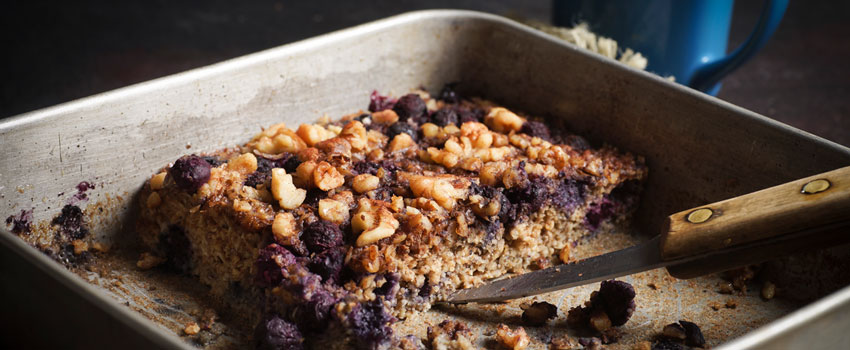Better cooking at home
Oatmeal Bake packs protein into breakfast meal

Seanne Safaii-Waite has spent a fair share of time around a select group of people: those who have lived to age 100 and beyond.
“A few summers ago, a colleague and I spent some time interviewing centenarians from Italy, Japan, Singapore and the U.S.,” Safaii-Waite said. “What we found … was the fact that protein intake was spread out throughout the day. That does not mean they were on Paleo diets, but rather their diets were high in plant-based protein, fish, beans and vegetables.
“There is much to be said about spreading protein intake throughout the day.”
But that’s not how most Americans eat. For example, a typical breakfast of milk and cereal or pancakes and juice contains only 5 to 10 grams of protein. Then, they tend to overeat at lunch or dinner.
“While it is relatively easy to eat enough protein at lunch and dinner, consuming 25 to 30 grams of protein at breakfast is extremely challenging, unless we eat fish or beans or a larger quantity of food, which poses the risk of overconsumption,” said Safaii-Waite, PhD, RDN, LD, a registered dietitian nutritionist working for St. Luke's Health System.
Fish for breakfast? Sure, some of us have added lox to our bagels – or are at least aware of that option – but few Americans find a way to incorporate fish into their breakfast diet.
“In Japan, fermented fish is a common breakfast food,” Safaii-Waite said. “Some other countries eat sardines for breakfast.”
But Safaii-Waite said, barring fish, there are plenty of other ways to add protein to your breakfast meals.
Consider these options: Egg whites, cottage cheese, beans, Greek yogurt, cheese and nuts.
Or better yet, try making a batch of Oatmeal Bake, Safaii-Waite’s contribution to our e-cookbook series. It’s not only delicious and nutritious, but it’s packed with 19 grams of protein per serving.
“We always serve this in my diabetes classes,” Safaii-Waite said. “The participants love it!”
Oatmeal Bake
Ingredients (step one):
2 cups old-fashioned oats
2 tablespoons crushed flax seed
2 tablespoons wheat bran
2 tablespoons oat bran
Nutmeg and/or cinnamon, to taste
Instructions (step one):
Mix dry ingredients together in a 6x9-inch or 7x10-inch oven-safe dish.
Ingredients (step two):
2 cups low-fat milk
1 egg
1 tablespoon vanilla
1 cup fresh blueberries
½ cup walnuts
Optional: brown sugar, honey or sugar-free sweetener
Instructions (step two):
Mix milk, vanilla and egg together in a mixing bowl and pour over dry ingredients in an oven-safe dish. Mix until the oats are well-covered with liquid.
Add blueberries to the top of mixture. Optional: Add brown sugar, honey or sugar-free sweetener to taste – but a very limited amount.
Place walnuts on top of mixture.
Bake in a 350-degree oven for approximately 20 minutes. For extra protein, add a dollop of Greek yogurt on each serving.
Makes four servings.
Nutritional information (per serving): 470 calories, 19 grams protein, 18 grams fat and 58 grams carbohydrates.
About The Author

Chris Langrill is a writer and copy editor for the St. Luke’s Communications and Marketing department.

